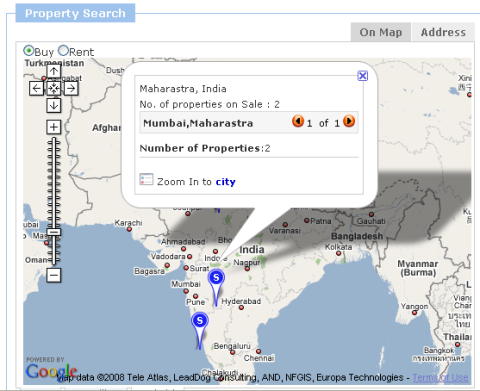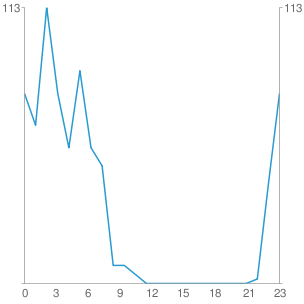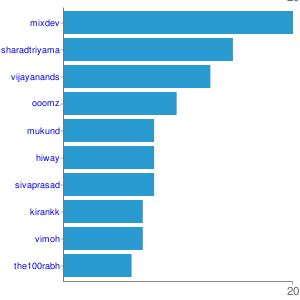World Usability Day 2008, Bangalore
November 13, 2008
World Usability Day (WUD) is a global initiative of the Usability Professionals’ Association to ensure that services and products important to human life are easier to access and simpler to use. Each year, in November, over 300 events are organized in over 40 countries around the world to raise awareness for the general public, and train professionals in the issues central to good usability research, development and practice.
The 2008 World Usability Day focuses on Usability in Transportation focussing on the interaction people and vehicles, the challenges and issues infrastructure and modes for moving around in our environment. World Usability Day 2008 is focused on exploring and creating awareness for several aspects of transportation in Bangalore and in India.
Details
Date : 29th November 2008
Time : 10.30 to 4.30 am
Venue : Yahoo campus (inner ring raod, domlur)
Register to participate on the UPA Bangalore wiki.
If you are going to be at the event, drop me a line in comments below or send me a message on Twitter.
Filed in Events I'm attending, Rich Internet Applications, Social Tech, Technology for real life, Usability, User Experience, User Interface, Web 2.0
Tags: Events I'm attending, how to build UX, UPA, UPA bangalore, Usability, usability india, usability professionals association, user centric design, User Experience, User Interface, UX, UX events, vinodh nandakumar, vinodhn, world usability day, WUD 2008
Featured on the Product Management View
November 7, 2008
It gives me great pleasure to announce that I will now be guest blogging for the Product Management View – a blog focussed on product management and strategy , run by world class product managers from various backgrounds and vast experience in this field.I am pleased to be associated with them and look forward to some great discussions over there. Thanks to Stewart Rogers from PM view for making this happen.
My first post for the Product management view is about maximizing product value through effective feature prioritization. Looking forward to hearing your thoughts on this topic and having some great conversations.
The PM view also tracks major webinars on product management, you can sign up for a webinar remider service and here’s the handle to the RSS feed.
Filed in Agile, Collaboration, geeky, Ideas!, information architecture, personas, product management, product reviews, Requirements gathering, Social Networking, Social Tech, Technology for real life, Usability, use cases, User Experience, Web 2.0
Tags: blog alliances, building web products, feature prioritization, feature triaging, indian bloggers, product management, product positioning, product strategy, strategies for web products, vinodh nandakumar, vinodh on product management view, vinodh on product managment, vinodhn
Understanding the new “social” consumer behavior
November 6, 2008
I just finished going through the Consumer experience report, from Razorfish a survey which has documented the online behavior and characteristics of more than 1,000 “connected” consumers on the internet. This was refreshing to read in the midst of all grim news and presentations from VC firms and the layoffs in internet firms.
The Consumer experience report looks at:
- People’s life online and their exchanges and networks that they build on the web
- Changing consumer behavior heralded by Web 2.0, UGC and the voice of the consumer
- what is the real impact of the “social web”;
- Key drives for transactions and purchases on the web
- and who is really using the mobile web and what are they doing.
The survey report is nicely documented and gives several key insights into online consumer behavior. If you are building a consumer internet product, it would suggest you go through this report.
Here are some thoughts I found encouraging, with potential for building opportunities on
- Search as the start of most online experiences
- Increasing importance of user experience design and designing for the “Facebook generation”
- Emergence of online video as a rising star and increased adoption across demographics
- Accelerated adoption of social media technologies at a breakneck speed – Increasing popularity of Twitter, Facebook and other social technologies which connect people and enable conversations
- Peer driven search and search from social recommendation sites driving digital commerce
- Market for smartphone is growing and adoption of online mobile services nascent
- Growth of mico conversations and social media tools like twitter -“I don’t remember how I kept in touch before!”
- Increased use of widgets which mashup data from various sources and can be accessed on the web and mobile
- Increased demand for data visualization and enabling users to track their activities over the social web.
So what are your thoughts on the report ? If you run an Internet startup, what are you doing to leverage this ?
You can download the entire report in PDF from here.
Filed in Collaboration, product management, Rich Internet Applications, Social Media, Social Networking, Social Tech, Startup, Startup Networking, Technology for real life, Usability, User Interface, Web 2.0
Tags: conversations, demographics, facebook, how the web is changing, internet, marketing, microblogging, PR, social, Social Media, social media evangelism, social media evolution, social media strategies, Social Networking, social web, twitter, understanding consumer behavior, understanding user experience, user behavior, users, Web 2.0, web 3.0
Understanding spatial search
November 4, 2008
So what is spatial search ?
In today’s context, where the Internet is the starting point for finding any information you need about anything in the world, and of course most of us use Google. The problem with traditional search is that it does not support or have information about the geographical dimension.
Why is spatial search important ?
This becomes extremely important when searching for something like “Guest houses in Bangalore”. Although the geographical location, in this case ‘Bangalore’ can be used as a part of search query term, the search engine does not interpret it as a geographical location.
So results for the search query – “Guest houses in Bangalore” will turn up documents with “Guest houses” and “Bangalore” and might not show up results with guest houses koramangala or indiranagar which are localities in Bangalore and also hence very apt results. This is because, the search engine does not have a relationship between these terms.
The other issue with traditional search in entities like homes is that the geographical information of these locations are not known, and hence they cannot be visualized on a map – which would be the most intuitive way to visualize these results.
While planning and architecting my100floors, we understood the need for Spatial search and helping users visualize home searches on maps. Moreover we felt that that searching for properties on maps was the intuitive way to find properties. In fact, we are the first to provide a map based search in India, cracking the problem of non-availability of geo-coded data.
The next post will talk about our implementation of Spatial search in, challenges we faced and a walk through of the user experience.
 my100floors.com is currently in closed beta, leave your email address on the site and drop me a line here or on twitter and I will make sure that you get the invite.
my100floors.com is currently in closed beta, leave your email address on the site and drop me a line here or on twitter and I will make sure that you get the invite.
Filed in Cool stuff, cool technology, design, geeky, Ideas!, product management, Requirements gathering, Rich Internet Applications, Search engines, Social Tech, Startup, Technology for real life, Usability, User Experience, User Interface, Web 2.0
Tags: product management, product strategy, Startup
Top Ten Disruptive Technologies
October 21, 2008
Following is Gartner’s list of Top ten disruptive technologies for 2008 to 2012
- Multicore and hybrid processors
- Virtualisation and fabric computing
- Social networks and social software
- Cloud computing and cloud/Web platforms
- Web mashups
- User Interface
- Ubiquitous computing
- Contextual computing
- Augmented reality
- Semantics
What do you think ?
Filed in Ideas!, Usability, User Experience, User Interface, Web 2.0
Tags: disruptive technologies, emerging trends, future, future technology trends, gartner, technology trends, vinodhn nandakumar
Top 10 Twitter tools for a power user
October 11, 2008
The Twitter obsession (and addiction) continues, we are all hooked on to it, aren’t we.
If you aren’t already, do follow me on Twitter.
So for all the Twitteratti / Tweeple / Tweeps out there, here’s my list of top 10 tools / plugins (in no particular order) for Twitter to enhance your Tweeting experience.
Tweetdeck

Tweetdeck takes all the information from Twitter and helps you manage the information overload by grouping them into managable pieces or based on your interests.
Twitturly

Tracks Top URLs which are talked about on Twitter. Extremely useful service and helps you find the most interestsing and latest information on the web.
Twitter Patterns

Helps you give your twitter page some style! They have some really cool designs, check it out.
Twitterfeed



Very useful app, which automatically tweets whenever you publish a post on your blog. Helps you get some link love!
Easy Tweets
A handy tool for online and digital marketers who wish to leverage the advantages of social media and microblogging. Easy Tweets enables you to switch between multiple Twitter accounts, track follower, replies etc all from one dashboard.
Hashtags
Hashtags enable you to track and follow conversations on Twitter. Follow @hashtags on Twitter and the service will index your tweets. Then add a #tagname to your tweet and this can be instantly looked up or searched.
Quotably

This service lets you follow a user’s conversations in a threaded manner, showing you all the various people the given user has had a conversation with. Interesting tool, especially when you trying to find out what others are saying about your brand/service.
Plodt
Power Twitter
Twitter Keys
Twitter keys is a fun tool for Twitter which enables you to use UTF8 symbols in your tweets. Once downloaded, this appears as a floating window, so all you need to do is to choose your symbol, copy n paste. So come on, get creative in your tweets using these symbols.

One special feature
Vakow
Vakow is an India focussed service which lets you post to Twitter as an SMS. Very useful and probably the cheapest way to pot to Twitter via mobile in India.
Let me know what you like and what tool you use.
Filed in Collaboration, Cool stuff, product reviews, Rich Internet Applications, Social Media, Social Tech, Startup, Usability, User Experience, User Interface, Web 2.0
Tags: product, product management, product marketing, product reviews, Social Media, social media marketing, social media strategies, social media tools, Startup, top to tools for twitter, twitter, twitter experience, twitter power user, twitter tools, vinodh nandakumar, vinodhn, vinodhn@twitter, Web 2.0
Startup strategies for handling the economic downturn
October 11, 2008
The slide deck below from Sequoia Capital is some solid advice about dealing with the entire economic crisis and recession from a startup standpoint. If you are an entrepreneur in any part of the world, I am sure there’s something useful for you in this deck.
In fact, the slides below give a good synopsis of the entire problem in the US and global markets and the effects which they have had on the global economy and how startups need to deal with new challenges and realities. I especially like slides 46-55, which are strategies which startups can adopt to get past the tough times.
What do you think ? If you run your own startup, what’s your strategy in dealing with the tough times ?
Filed in Agile, Good bad and ugly, Ideas!, product management, Startup, Valuations, Web 2.0
Tags: advice for startups, Sequoia Capital, Startup, startup management, strategic management, strategic thinking, strategies, VC, venture capital, vinodh nandakumar, vinodhn, vinodhn@twitter
Of twitter, microblogging et all
September 18, 2008
Twitter, of course has been one of the main reasons why I don’t get time to write on this blog. Most of the times, 140 characters seems to be more than enough to convey what I want to say. Moreover, I always end up having very interesting conversations there and the there’s always instant feedback from a set of very engaged audience.
I have now been using Twitter seriously for sometime now, so thought so sharing some stats. Thanks to Twitter Stats and TweetStats which helped me to churn out these graphs.
Tweets per hour


Tweets per day
Twitter Timeline
Top @replies
So if you are already on twitter, follow me.
Filed in Collaboration, Cool stuff, cool technology, geeky, Ideas!, mashups, Rich Internet Applications, Social Media, Social Tech, Startup, User Experience, Web 2.0
Tags: microblogging, Social Media, social media strategy, Social Tech, twitter, twitter stats, using social media, vinodh nandakumar, vinodhn, vinodhn@twitter
China Internet and Web 2.0 trends
August 27, 2008
The slide deck below has some really great information on Internet and Web 2.0 trends in China, a market that most of us are not really clued into. Thanks to Trendspotting for putting together this data packed slideshow.
Here what I find most interesting and insightful from the information
- China has the largest internet user base in the world to the tune of 253m users. They also have the largest mobile subscriber base of 574m.
- China has a very health internet user sex ratio comprising of 47% women
- IM, Online music and Online Video/movies are the top three online channels for Chinese youth
- Out of the top 5 sites in China based on traffic, Yahoo China (No.5) is the only international player out them, others are all local players.
- Chinese participation in Social media sites is higher than the global daily average.
- Bulletin Board Sites (BBS) are extremely popular
- The Total online ad spend per internet user in China is only at $8, however the ad market has heated up and is growing at 50% with increased ad spends due to the Olympics
- Internet censorship and moral policing are very common in China, in fact 85% of Chinese approve government internet censorship.
So what’s your take on the Chinese internet market ? Do you have more insights ? What do you think are future trends in China ?
Filed in geeky, product management, Rich Internet Applications, Social Media, Social Networking, Software outsourcing, Startup, Technology for real life, Usability, Valuations, Web 2.0
Tags: business research china, china, china internet, china internet censorship, china web2.0, chinese internet, internet, market analysis, market analysis of china internet and web 2.0 trends, product, product management, product strategy, Rich Internet Applications, top sites in china, web, Web 2.0
Re-thinking your online presence
August 22, 2008
Does your brand or company have a website ? I’m pretty sure it does. Well if you thought that it’s the end of your online presence, then it’s high time you rethought your web strategy. You might be running a highly successful offline business, but your social media strategy can be a game changer.
If your brand or firm is not participating in Social Media using tools that include a collection of blogs, wikis, forums, photos and videos sharing sites, then you really don’t have an online presence.
These days Social Media such as forums, wikis and blogs in particular are playing a notable role in influencing the buying patterns of consumers. Often consumers look for opinions, user experiences and reviews on such sources before purchasing a product. Detecting influential nodes and opinion leaders and understanding their role in how people perceive and adopt a product or service provides a powerful tool for marketing, advertising and business intelligence.  Look at these insights from a very comprehensive research study by Universal McCann.
Look at these insights from a very comprehensive research study by Universal McCann.
- 73% of online users read a blog
- 57% join social networks
- 45% have started a blog
- 83% have viewed a video online
- 39% subscribe to RSS feeds
- 36% think more positively about companies that have blogs
I find the last insight extremely encouraging, and I hope that this will encourage you to rethink your brand’s online marketing strategy.
What are your thoughts ? If you are running a highly successful offline business, how are you leveraging social media as a touch point with your customers ?
Filed in Ideas!, Latest tech, product management, Social Media, Social Networking, Social Tech, Startup, User Experience, Web 2.0
Tags: brand, brand management, leveraging social media, nodes, online marketing, product management, product strategy, social influence, Social Media, social media brand building, social media marketing, social media strategies, strategic thinking, strategy., using social media












